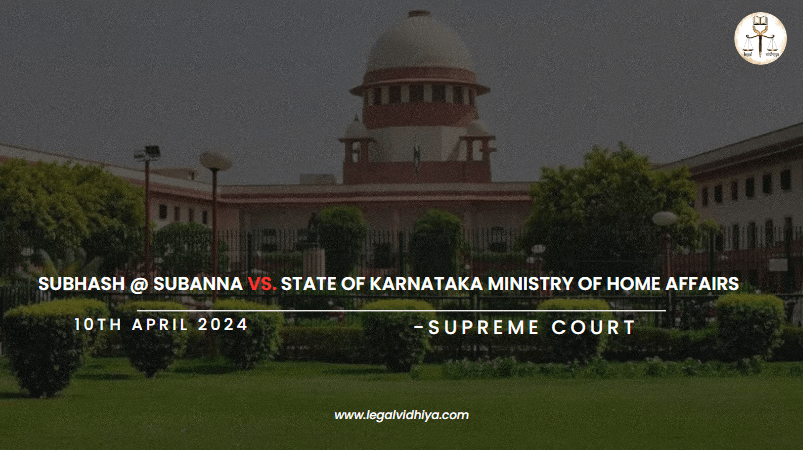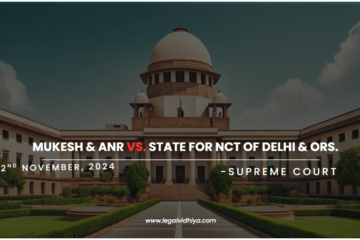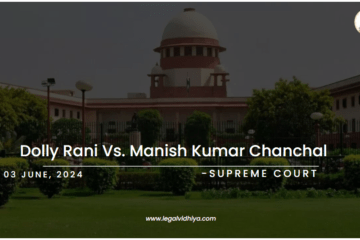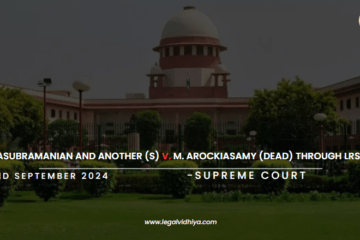
| CITATION | 2024 INSC 294 |
|---|---|
| DATE OF JUDGMENT | 10th April 2024 |
| COURT | Supreme Court of India |
| APPELLANT | Subhash @Subanna &Ors. |
| RESPONDENT | State of Karnataka Ministry of Home Affairs. |
| BENCH | Sudhanshu Dhulia and Prasanna B. Varale, JJ. |
INTRODUCTION
The case of Subhash @ Subanna & Ors. Vs. State of Karnataka Ministry of Home Affairs revolves around a tragic family conflict that escalated into a violent altercation resulting in the untimely death of Mahadevappa Natikar. Emerging from a seemingly innocuous dispute over a blocked path, the confrontation between Sangeeta, Mahadevappa’s daughter, and her uncle Subhash on February 17, 2009, set the stage for subsequent events. The following day, Mahadevappa, accompanied by his sons, confronted Subhash regarding the obstruction, triggering a violent struggle at Subhash’s residence. In the ensuing altercation, Mahadevappa suffered severe injuries inflicted by Subhash and his family members, including appellants Dattatrey and Digambar. Despite attempts to intervene by Mahadevappa’s family, the confrontation resulted in Mahadevappa being found unconscious and critically injured, ultimately succumbing to his wounds upon arrival at the hospital. The case underscores the complexities of criminal law, particularly in evaluating claims of self-defense and determining culpability in cases of fatal violence.
FACTS OF THE CASE
- On February 17, 2009, a confrontation arose when Sangeeta discovered firewood blocking her path, leading to a verbal altercation with her uncle Subhash.
- The following day, February 18, 2009, Mahadevappa, accompanied by his sons, approached Subhash’s residence to address the obstruction issue, initiating a confrontational situation.
- This confrontation escalated into a violent struggle between Mahadevappa and Subhash’s family members, during which Mahadevappa sustained severe injuries.
- Subhash, along with appellants Dattatrey and Digambar, assaulted Mahadevappa, causing him significant harm, including head injuries and lacerations.
- Mahadevappa’s family, including his daughter Sangeeta and son Sharanappa, witnessed the assault, with Sharanappa attempting to intervene but also getting injured in the process.
- Following the assault, Mahadevappa was found unconscious and severely injured by neighbors who rushed to the scene upon hearing the commotion.
- Efforts were made to transport Mahadevappa to the hospital for medical treatment, but tragically, he was pronounced dead upon arrival.
- In response to the incident, Sangeeta filed a First Information Report (FIR) against the accused, alleging various offenses under the Indian Penal Code (IPC).
- Subsequent to the filing of the FIR, police conducted a thorough investigation, gathering evidence, including witness statements, medical reports, and other relevant documentation.
- Based on the findings of the investigation, the accused were charged and brought to trial, where they pleaded not guilty to the charges leveled against them.
- Despite their pleas, the accused were found guilty by the Sessions Court, which handed down convictions and sentences in accordance with the law.
- Dissatisfied with the verdict, the accused filed an appeal challenging the decision of the Sessions Court, which led to the matter being brought before the High Court for review.
- Upon review, the High Court upheld the convictions and sentences imposed by the Sessions Court, prompting the accused to seek further recourse by petitioning the Supreme Court.
- The Supreme Court agreed to review the case, considering the complexities and implications involved, and conducted a thorough examination of the evidence and legal arguments presented.
- After careful consideration, the Supreme Court rendered its judgment, affirming the convictions and sentences imposed by the lower courts, thereby bringing the legal proceedings to a conclusion.
ISSUES RAISED
1. Did the evidence and circumstances support the appellants’ conviction for murder under Section 302 IPC, which carried a life sentence?
2. Did the appellants use their right to private defence during the incident, or did the deceased and his family members incite the appellants’ actions?
3. Under Section 304 Part II IPC, could the appellants’ actions be categorized as culpable homicide rather than murder in light of their alleged provocation and lack of intent to kill, as opposed to murder under Section 302 IPC?
4. In order to be found guilty under Section 302 IPC, did the prosecution provide enough evidence that the appellants intended to kill Mahadevappa?
5. Did the lower courts properly consider the provocation and right to self-defense claimed by the appellants in rendering their verdict?
CONTENTIONS OF APPELLANT
1. The appellants contended that the confrontation initiated by Mahadevappa and his family members provoked their actions, leading to a defensive response during the altercation at Subhash’s residence.
2. They argued that there was insufficient evidence to prove their intent to murder Mahadevappa, asserting that their actions were reactive rather than premeditated.
3. The appellants maintained that the incident, at most, constituted culpable homicide not amounting to murder under Section 304 Part II IPC, emphasizing the absence of a clear intention to cause death.
4. In their appeal, they criticized the lower courts for allegedly disregarding the provocation and their right to self-defense, asserting that these factors were not adequately considered in the verdicts.
CONTENTIONS OF REPONDENT
1. The respondents upheld the convictions and sentences imposed by the Sessions Court and the High Court under Sections 302, 324, and 326 of the Indian Penal Code (IPC), asserting that the evidence convincingly proved the guilt of the appellants.
2. They argued that Mahadevappa’s assault and subsequent demise were directly caused by the deliberate actions of the appellants, dismissing any claims of self-defense and asserting that the violence was unwarranted.
3. The respondents contended that the level of violence displayed by the appellants went beyond any reasonable response to the alleged provocation, indicating a clear intent to cause harm or death, as evidenced by the severity of Mahadevappa’s injuries.
4. They underscored the consistency and credibility of witness testimonies, endorsing the prosecution’s case and supporting the decisions of the lower courts based on the testimonies of key witnesses.
JUDGEMENT
The Supreme Court overturned the High Court’s ruling, stressing the importance of understanding the context behind the High Court’s determination regarding the exceeding of quotas by Promotee Inspectors (PRIs). The High Court’s decision aimed at rectifying situations where vacancies meant for direct recruits were not properly disclosed to the public service commission, thus giving an unfair advantage to promotees over later-appointed direct recruits. By categorizing promotions as ad-hoc, the High Court intended to address cases of underreported vacancies.
However, the Supreme Court argued that the correct approach, as adopted by the Central Administrative Tribunal (CAT), should have been to evaluate the number of regular vacancies in relation to the quotas, with specific consideration given to the vacancy register. Consequently, the Supreme Court concluded that the promotions of the PRIs should be regarded as regular. The court deemed the High Court’s oversight of these factors as a clear mistake, as the records indicated that the prohibition on direct recruitment did not extend to vacancies intended to be filled through promotions in accordance with the Recruitment Rules.
ANALYSIS
The Subhash @ Subanna & Ors. Vs. State of Karnataka Ministry of Home Affairs case offers a poignant example of the intricate nuances within criminal law, particularly concerning matters of self-defense and provocation. The Supreme Court’s thorough examination of the evidence, encompassing witness testimonies and medical documentation, presented a vivid depiction of the events leading to the tragic demise of Mahadevappa. Despite the appellants’ claims of acting in self-defense and being provoked, the court concluded that their response was excessive and unwarranted, underscoring the imperative of accountability in instances of violence.
Moreover, the court’s decision to uphold the convictions and sentences imposed by the lower courts underscores the significance of adhering to the principles of justice and ensuring redress for victims and their families. By dismissing the appellants’ justifications and affirming the gravity of their actions, the court unequivocally communicates that acts of violence will neither be tolerated nor excused, irrespective of the circumstances. This case serves as a somber reminder of society’s collective duty to prevent and address violence, while also reaffirming the judiciary’s mandate to uphold integrity and responsibility in the dispensation of justice.
CONCLUSION
The Subhash @ Subanna & Ors. Vs. State of Karnataka Ministry of Home Affairs case highlights the tragic outcome of a family dispute escalating into violence. Despite assertions of provocation and self-defense, the evidence presented during the trial, including witness testimonies and medical reports, convincingly established the guilt of the defendants. Through a comprehensive review of the case, the Supreme Court affirmed the decisions made by the lower courts, thereby upholding the convictions and sentences imposed on the accused.
This ruling not only ensures justice for the victim, Mahadevappa, but also serves as a stark reminder that acts of violence, particularly those resulting in loss of life, will be met with accountability and legal repercussions. By upholding the principles of justice and condemning unjustifiable violence, the court’s verdict aims to provide solace to the victim’s grieving family while reaffirming society’s dedication to justice and the safeguarding of its members from harm.
REFERENCES
- SCC Online
- https://www.verdictum.in/court-updates/supreme-court/subhash-subanna-v-state-of-karnataka-2024-insc-294-right-to-private-defence-not-established-bodily-injury-not-accidental-1530092
- Indian Kanoon
This Article is written by POORNA.R student of School of excellence in law, Chennai; Intern at Legal Vidhiya.
Disclaimer: The materials provided herein are intended solely for informational purposes. Accessing or using the site or the materials does not establish an attorney-client relationship. The information presented on this site is not to be construed as legal or professional advice, and it should not be relied upon for such purposes or used as a substitute for advice from a licensed attorney in your state. Additionally, the viewpoint presented by the author is of a personal nature.




0 Comments